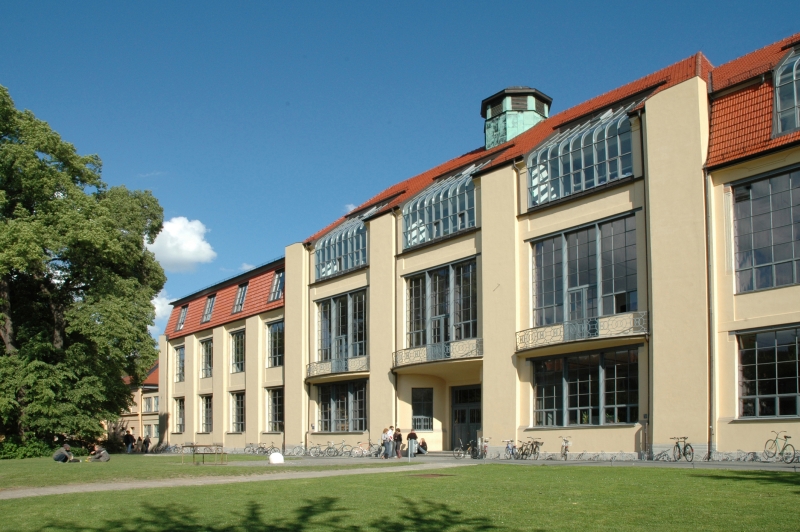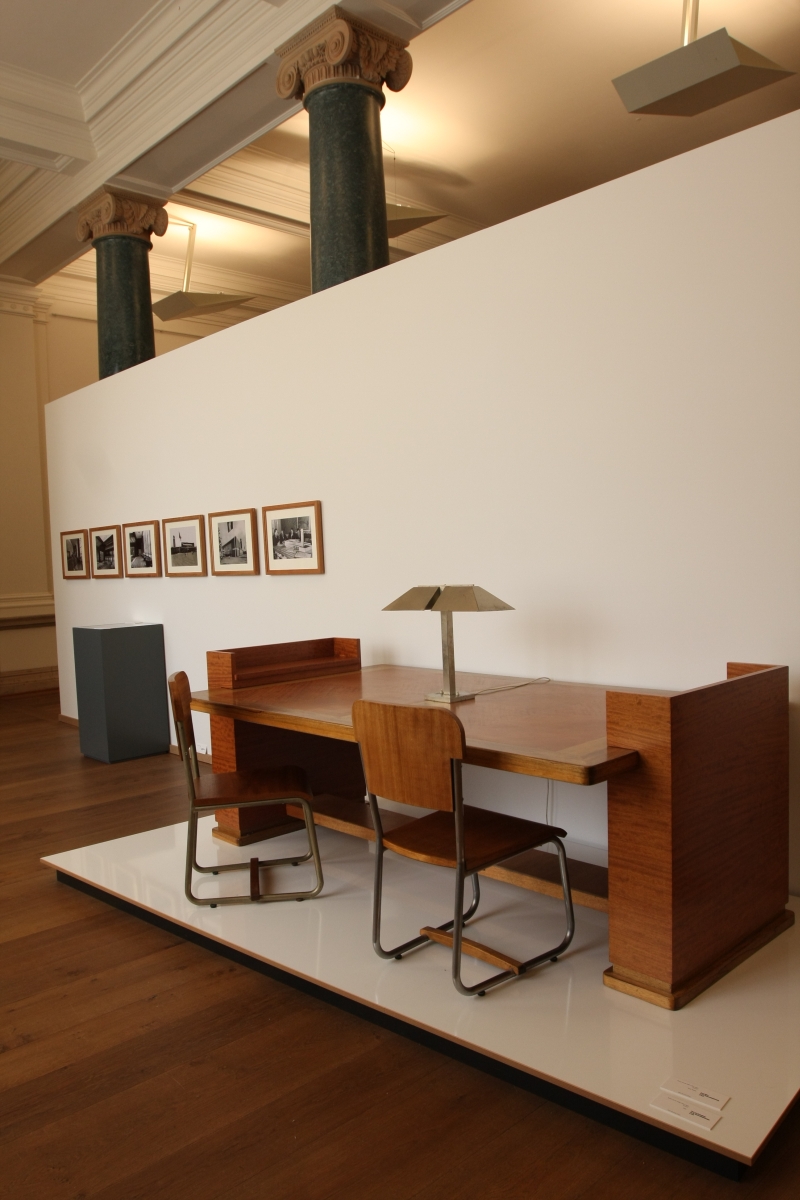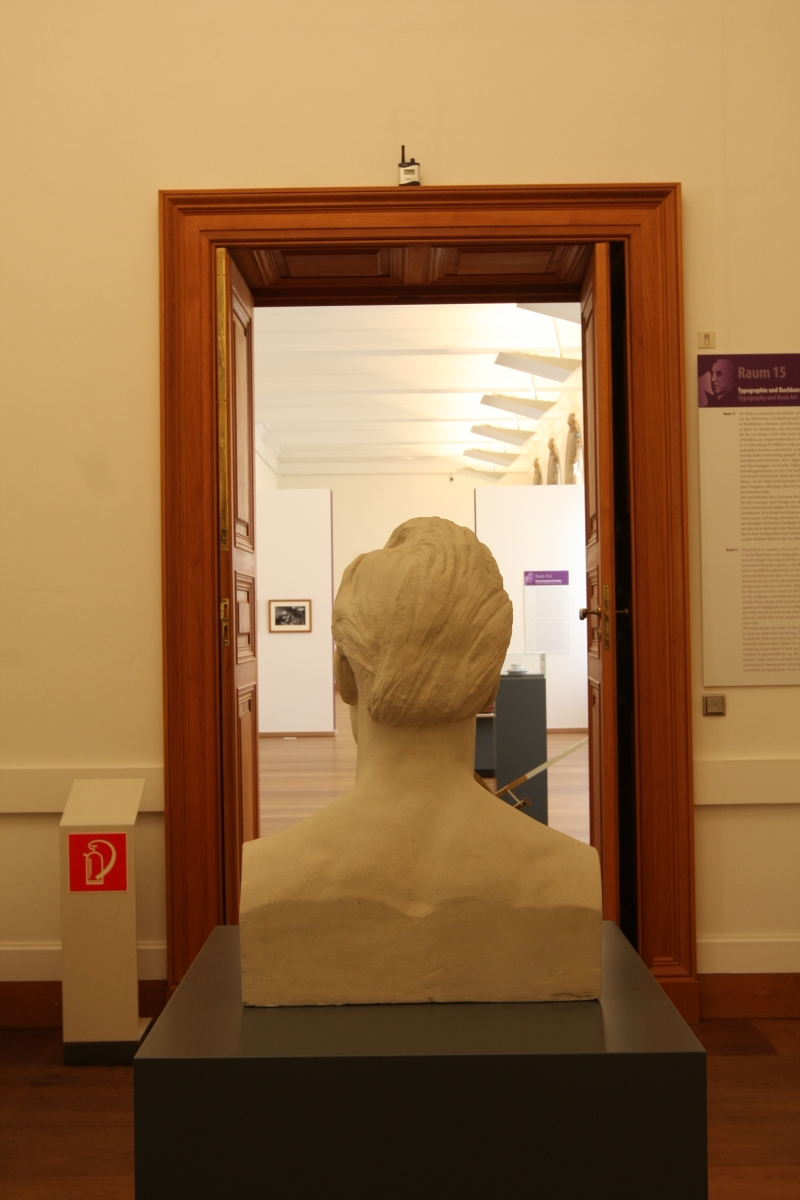smow blog Design Calendar: April 3rd 1863 – Happy Birthday Henry van de Velde!
Henry van de Velde not only helped define Art Nouveau, he was also party to Art Nouveau’s christening; even if the immediate reception didn’t bode all too well for the fledgling movements longevity…………………
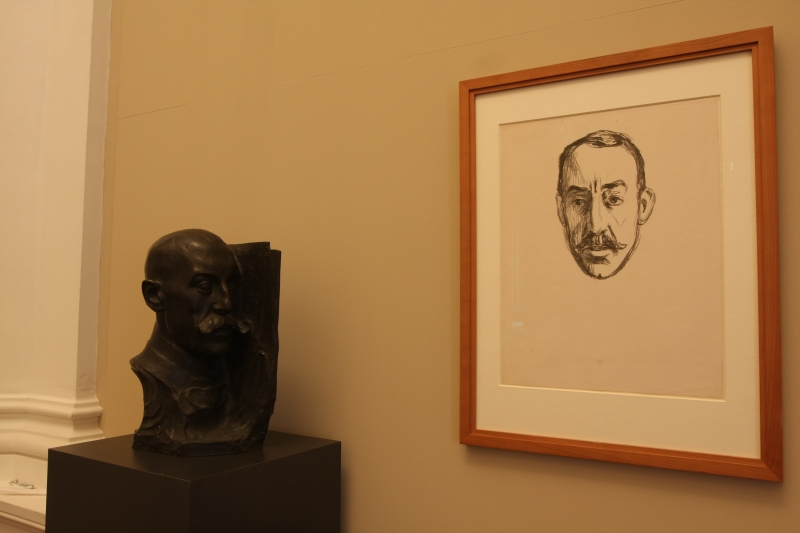
Henry van de Velde meets Henry van de Velde, here as seen at the exhibition Henry van de Velde. Leidenschaft, Funktion und Schönheit, Klassik Stiftung Weimar, 2013
Born in Antwerp on April 3rd 1863 Henricus Clementinus van de Velde1 initially trained as a painter, studying first at the Royal Academy of Fine Arts in Antwerp and subsequently as a student of the portrait painter Charles-Emile-Auguste Durand in Paris. In 1888, and after numerous residences, and flirts with as many artistic styles, Henry van de Velde was admitted into the Brussels’ artist group “Les XX”, an organisation who from their founding in 1883 gradually evolved from pure art to a mixture of pure and applied arts; their annual exhibition in 1891 being the first to feature book design, posters and ceramics alongside paintings2, and corresponded to a display of arts and crafts works by London based company Liberty in the window of the “Compagnie Japonaise” store in Brussels, a display which clearly made an impression on the then 28 year old Henry van de Velde, “We savoured these items as if they were a Spring suddenly brought into our lives, a Spring brought into our dull, grey houses with their heavy, threadbare furniture which chokes all gaiety, with all those dusty useless objects around which we weave. In contrast the window of Compagnie Japonaise in the Rue Royale shone like a chapel; refreshing our eyes, freeing our emotions, like the soul of the believer following prayer.”3
Henry van de Velde’s first applied work, a Broderie, was subsequently displayed at the 1892 Les XX exhibition and shortly afterwards Henry van de Velde turned his back on painting and diverted his energies instead to architecture, interior design, product design, journalism and teaching, the latter being a career branch which began in 1894 as tutor for “The Industrial Arts and Ornamentation” at the newly established Université Nouvelle in Brussels and one in which Henry van de Velde is unquestionably best known as the founding director of the Großherzoglich-Sächsische Kunstgewerbeschule in Weimar, the forerunner – both spiritually and physically – of Bauhaus. An autodidact and multi-talent Henry van de Velde died in Switzerland in 1957 aged 95, and left as a legacy an unparalleled canon of architecture, furniture, book designs, textile designs, corporate designs, paintings and sculpture. An important moment in Henry van de Velde’s career, his break if you will, came in December 1895; even if “break” was initially implied in the more negative sense.
In spring 1895 Henry van de Velde was visited at his home in Uccle near Brussels by the Paris based, Hamburg born art dealer Siegfried Bing and the Berlin based art critic and publisher Julius Meier-Graefe4*: the former had intentions of transforming his gallery from its then focus on Japanese arts and crafts into one devoted to contemporary European arts and crafts, the latter guided him to some potential collaborators.
The path to Uccle wound over furniture by Henry van de Velde which Julius Meier-Graefe had encountered on a visit to the Brussels studio of the Belgian architect Victor Horta. In a subsequent article for the magazine Neue Deutsche Rundschau Meier-Graefe praised van de Velde, together with unnamed “Dutch colleagues”, for the way they “strictly subordinate their art the utility of the objects” and that in van de Velde’s case “it is furniture which above all is conducive to use”5
In early summer 1895 Henry van de Velde travelled to Paris where Siegfried Bing outlined his plans in more detail and for all that rather than presenting the various works, museum style, on pedestals, he intended “to present proper salons and rooms. New types of furniture, lighting, wallpaper, textiles, carpets – all these furniture and furnishings should be part of a living unity”6
As part of the project Henry van de Velde was commissioned to design “a large dinning room, a smoking room in congo-wood, a small closet in satinwood, and a large rotunda-like room with furniture and wall panels, and all in a coordinated, harmonised fashion”7; a commission which meant that Henry van de Velde was responsible for the vast majority of the interior design and which in addition represents what Catherine Krahmer describes as van de Velde’s “first, bold, step into the public sphere”8. And one that caused him serious headaches, “until then all that I had created was for existing rooms and for a client whose tastes and needs I knew” he recalls in his memoirs, “Working for an unknown customer and a non-existent room was foreign.”9 A statement which of course also neatly encapsulates the change in mindset that accompanied the transfer from those “designers” before van de Velde who worked exclusively on private commissions, and those after van de Velde who designed for industry.
“Only slowly and with great difficulty did I become accustomed to this unfamiliar situation,” he confides, “while fearing being unable to deliver the objects on time”10
Deliver however he could and on December 26th 1895 Siegfried Bing opened his “Salon de l’Art Nouveau” in Paris’s rue de Provence, an institution which by default is generally considered the eponym of the movement. Yet despite presenting a catalogue of over 600 works by the likes of Émile Gallé, Walter Crane, Louis C. Tiffany or Georges Lemmen11, and promising the citizens of Paris the first glimpse of a brave new future, the opening turned into a very public scandal.
Or as Henry van de Velde recalled it, ” … a glorious adventure and memorable defeat”12
Or put another way
“An elegant mass surged into the rooms, loud, hostile and indignant. The cream of Parisian society, famed members of the Académie française, artists, and important intellectuals, aesthetes and art critics were united in their belief that here the traditional style was under attack and a revolutionary breach was being formed, which implied something unforgivably insulting”13
And that although one could have expected that the average Parisien would, should, have approved of anything revolutionary; however, the famed French appétit for revolution apparently does not extend to their furniture and furnishings. Or their architecture when one considers the opposition to Le Centre Pompidou.
The reaction of the press was equally, if not universally, critical.
Writing in the La Liberté, for example, Alfred Pallier considered the Salon “decadent and dismissed the exhibition as a misguided commitment to symbolism”14, La Chronique des Arts noted that in addition to the unfortunate choice of name “there is, properly speaking, nothing original. There are beautiful things in disorder but nothing can be feared or hoped from this smallest of artistic revolutions”15
The charge however was led by the art critic Arsène Alexandre in a front page article in Le Figaro on December 28th 1895. “Let’s now enter the hotel de l’Art Nouveau.” he wrote, “We encounter there a confusion of lines and colours, a lack of science, which creates only novelty ….. the broken bottle plays a big role in L’Art Nouveau: it’s dazzling and brutal. It has no significance as an ornamental element, is stupefied and looks like a tinsel fairyland ….. on several floors are arranged paintings and prints, around which reigns an authentic wrought iron bannister from the eighteenth century and which flicks an ironic finger at all the indigestible architecture and furniture.” Siegfried Bing, so Alexandre, is “an amiable, courteous and nervous man under the curious illusion he can wed America with Japan and Montmartre”16
“I left tired, sick, exasperated, my nerves shattered and my head full of nightmares of dancing bottles. Impressions I had never felt before with works, classic or contemporary, which are not of l’Art Nouveau”17
Arsène Alexandre also completely unnecessarily, and inexcusably, adding that “All this smacks of the vicious Englishman, the morphine addicted Jew or the Belgian rogue, or a nice salad of these three poisons”18
Thankfully the quality of art and design criticism in Le Figaro has risen considerably over the course of the past 100+ years
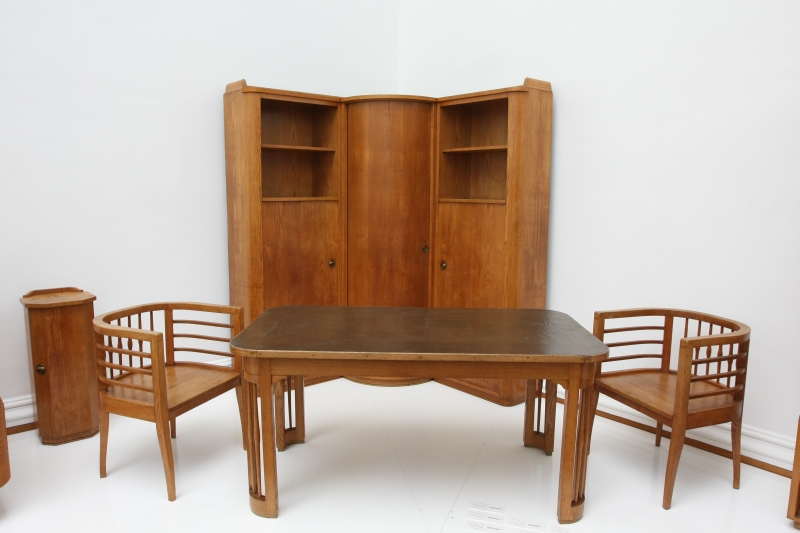
Kids furniture by Henry Van de Velde for the Willy Engels, here as seen at the exhibition Henry van de Velde. Leidenschaft, Funktion und Schönheit, Klassik Stiftung Weimar, 2013
Particular derision was directed at Henry van de Velde personally; something one presumes in light of Monsiuer Alexandre’s comments, had as much to do with his Belgian nationality as the quality of his work.
After criticising the dinning room as being from “a group of English workers under the leadership of a Belgian” Arsène Alexandre continues to deride that “from the same Belgian M. van de Velde originates a smoking room containing furniture which aims for form, but are unformed, and with wall panels featuring arabesques that make one dizzy”, before concluding “L’Art Nouveau means to teach us that the English are good carpenters and the Belgians no longer know what a line is? We knew that…..” 19
Outside the Maison l’Art Nouveau the mood of the attending public was just as hostile to van de Velde’s work. The French writer and critic Edmond de Goncourt let it be known that in his opinion, “the most ridiculous of the exhibitors, van de Velde, designs his furniture according to the principles of ship building. It appears as if he practices a “Yacht Style””20, while Auguste Rodin, himself represented in the Salon with three sculptures and an artist who had been admitted to Les XX on the same day as van de Velde, declared that “your van de Velde is a Barbarian!”21 Which of course reminds of the criticism half a century later that Ferdinand Kramer’s reconstruction of the main entrance of Frankfurt University amounted to “modern Barbarism.” Kramer got his revenge by sending a foot from one of the dismounted neo-Baroque figures to his critic with the note “As a consolation for the indignant. The Barbarian”.22 Henry van de Velde was much more diplomatic “… this crushing attack was not as disparaging as the grandmaster believed. He, who so adores the cathedrals and who so admires their constructors, should have been aware that the Gothic style – especially in France – was considered the invention of Barbarians. I could be proud to be pilloried as their relative”23
Aside from his obvious immense and unshakable self-confidence Henry van de Velde could also take heart from the support expressed in more sympathetic sections of the press. Writing in Le Journal Gustave Geffory is recorded as having written, “… these men are on the search for a simpler and deeper art; in which cause they employ a good method: incessant work” and “when one, for example, observes the rooms by Henry van de Velde, one observes a harmony in the line of all the furniture, something which has been consciously realised”24, while in Revue biblio-iconographique Octave Uzanne notes, in an otherwise largely critical article, that “the dining room made with great art, simplicity and science by M. Van de Velde is the real highlight of la Galerie Bing”.25 One of the more entertaining articles on the Salon de l’Art Nouveau was written for the London based magazine “The Studio” by their Paris correspondent Gabriel Mouray and in which he writes that “M. Bing, it must be said, has been somewhat roughly handled by the press” and that somewhat unfairly as his efforts “are certainly deserving of encouragement, not so much on account of the actual results achieved, as from the ideas whence they have sprung” and while although himself very critical of the way Siegfried Bing organised and presented his exhibition Gabriel Mouray’s opines that “his scheme, after all, deserves support, and, if it lasts, may one of these days be the means of bringing out really good work, and removing the frightful, the deplorable stagnation in regards to decorative art in which we are now involved”26
A wish/prophecy which was to become largely fulfilled as over the subsequent decade Art Nouveau rose to become the predominant style amongst cultured Europeans, and, and even if one should, nay must, query many of the aesthetic and formal decisions taken by the artists nouveau, their new thinking about form, function, purpose and ornamentation unquestionably helped solve this “stagnation” and opened up numerous bright new futures.
Nor was Henry van de Velde’s career overly troubled by the less than glorious start in Paris: in 1896 he successfully presented the furniture he had created for his own Bloemenwerf house at the La Libre Esthétique exhibition in Brussels; in 1897 his Paris room designs were presented to a more welcoming and appreciative public at the International Kunstausstellung in Dresden; in 1899 he completed several large commissions in Holland, Germany and France and in the following decades would go on to become one of the genuine forefathers and guiding lights of what we understand today, and enjoy, as contemporary architecture and design.
Which just goes to show, you should never let yourself be deflected in your ambitions and ideals by a group of angry French artists and academics. Far less by a comparison with the Barbarians. For, and as we have noted before, sometimes progress needs a little bit of controlled barbarism to keep it on the straight and narrow.
Happy Birthday Henry van de Velde!
1. Birgit Schulte, Henry van de Velde. Die Lebensreise 1863 – 1957, in Henry van de Velde. Ein europäischer Künstler seiner Zeit, Wienand Verlag, Köln, 1992
2. Henry van de Velde, Geschichte meines Lebens, Piper Verlag, München, 1962
3.ibid
4.ibid [*If that was really the case seems unlikely based on other sources, however it is how Henry van de Velde remembers events, although one must add his memories do often come across as simplified and annotated by the mists of time. Are however very entertaining]
5.Julius Meier-Graefe, Dekorative Kunst, Neue Deutsche Rundschau Jahrg VII, Heft 6, Juni 1896
6. Henry van de Velde, Geschichte meines Lebens, Piper Verlag, München, 1962
7. ibid
8. Catherine Krahmer Über die Anfänge des Neuen Stils. Henry van de Velde – Siegfried Bing – Julius Meier-Graefe, in Henry van de Velde. Ein europäischer Künstler seiner Zeit, Wienand Verlag, Köln, 1992
9. Henry van de Velde, Geschichte meines Lebens, Piper Verlag, München, 1962
10. ibid
11.Salon de l’art nouveau, Catalogue December 1895, Paris
12. Henry van de Velde, Paris und das Europäische Kunstgewerbe, Die Neue Rundschau, Jhrg. 36, Heft 10, Oktober 1925
13. Henry van de Velde, Geschichte meines Lebens, Piper Verlag, München, 1962
14. Gabriel P Weisberg, Art Nouveau Bing. Paris Style 1900, Abrams, New York, 1986
15. L’Art Nouveau in La Chronique des Arts, 11.01.1896, quoted in French in Gabriel P Weisberg, Art Nouveau Bing. Paris Style 1900, Abrams, New York, 1986
16. Arsène Alexandre, L'”Art Nouveau” Le Figaro, 28.12.1895, Paris
17. ibid
18. ibid
19. ibid
20. Henry van de Velde, Geschichte meines Lebens, Piper Verlag, München, 1962
21. ibid
22. Wolfgang Voigt et al Ferdinand Kramer. Die Bauten, Ernst Wasmuth Verlag, 2015
23. Henry van de Velde, Geschichte meines Lebens, Piper Verlag, München, 1962
24.
25. Octave Uzanne, Le Salon de l’Art Nouveau, Revue biblio-iconographique, 25.01.1986, Paris
26. Gabriel Mouray, Studio-Talk. Paris. The Studio. An Illustrated Magazine of Fine and Applied Art Volume 7 No 35 February 1896 London
Tagged with: Antwerp, Art Nouveau, Brussels, Henry van de Velde, Paris
